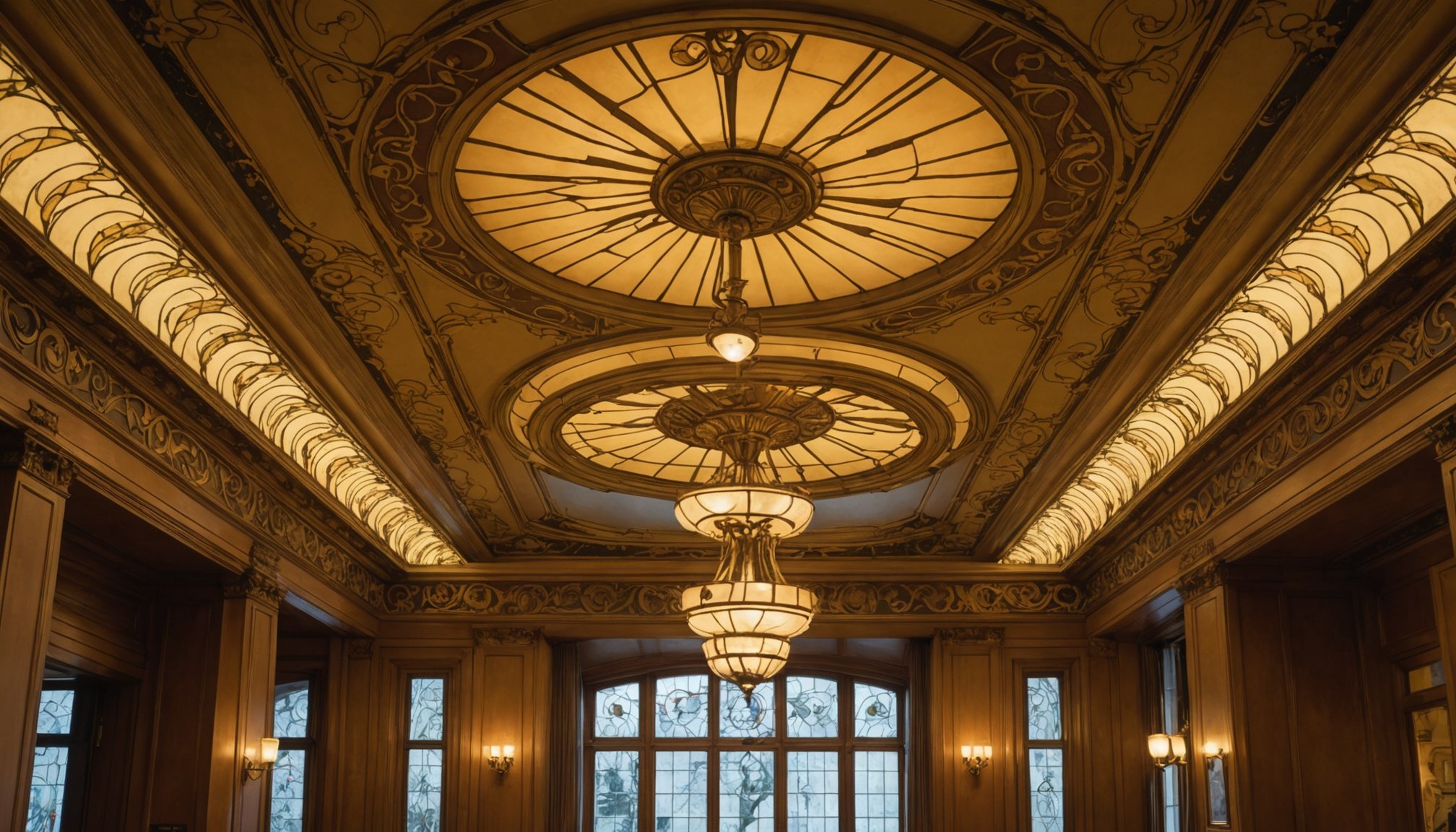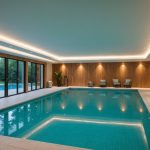Understanding Art Nouveau Lighting Design
Art Nouveau emerged as a decorative arts movement in the late 19th and early 20th centuries, defined by its emphasis on natural forms and intricate design principles. This style sought to break away from previous ornate styles, embracing flowing lines and organic motifs. A key aspect of Art Nouveau lighting is its ability to transform functional items, like lamps, into pieces of art.
The design principles of Art Nouveau lighting showcase a deep appreciation for craftsmanship. Key characteristics include the use of materials like glass and metal, often featuring asymmetrical shapes and curvilinear forms. These elements not only provide illumination but also serve to enhance the overall aesthetic of the space.
Lire également : Top Materials for Creating a Long-lasting and Chic Kitchen Backsplash in the UK
Harmonizing lighting with architectural features is vital in Art Nouveau interiors. The lighting should complement architectural elements, from elaborate molding to unusual window shapes, creating a cohesive environment. Integrating light fixtures that align with the architecture ensures that each piece contributes to the overall thematic unity. This attention to detail exemplifies the Art Nouveau ethos, where every component is purposefully designed to contribute to an immersive, harmonious setting.
Selecting Art Nouveau Lighting Fixtures
When it comes to choosing Art Nouveau Lighting Fixtures for your home, the variety of available designs can be enchanting. There are many types to explore, from intricate chandeliers and wall sconces to elegant table lamps and floor lamps. Each fixture offers a unique take on the Art Nouveau style, characterized by its organic lines and nature-inspired motifs.
A voir aussi : Stylish Storage Solutions to Tidy Up Your UK Hallway: Balancing Elegance and Organization
Considering the scale and proportion is crucial when selecting these fixtures. A large chandelier might overpower a small room, while a dainty lamp could get lost in a spacious hall. It’s important to ensure that the Lighting Fixtures complement the existing home decor in both size and aesthetic harmony.
Color palettes and materials commonly found in Art Nouveau designs further enhance their appeal. These often feature soft hues such as muted greens, browns, and golds, reflecting the natural world. Materials like stained glass, wrought iron, and polished brass are frequently used, adding to the fixtures’ distinct character. For coherence, select pieces that not only fit the intended room’s scale but also blend or contrast tastefully with other decorative elements.
Incorporating these fixtures thoughtfully can transform a living space, infusing it with elegance and artistic flair.
Positioning Lighting to Enhance Architectural Features
When it comes to architectural illumination, understanding where and how to place your lighting can bring out the best in your home design. The placement of lights is crucial to ensure that architectural elements are properly highlighted, adding layers and dimensions to your space.
Illuminating Key Architectural Details
Strategic lighting placement can accentuate key architectural details such as moldings and trims. By directing light towards these features, you can create an interplay of light and shadow that not only draws attention but also adds depth and sophistication to the overall atmosphere of a room. Consider placing lights above or below intricate trims to highlight their unique shapes and textures.
Layering Light for Depth
Layering your lights doesn’t just illuminate spaces—it introduces texture and richness to home design. Using a combination of ambient, task, and accent lighting, you can achieve a multi-dimensional environment where each level of light serves a purpose. By varying the intensity and direction of light sources, you can enhance architectural features and create a balanced environment.
Creating Focal Points with Lighting
To create focal points, direct lighting towards your desired architecture or art. Use spotlights to highlight sculptures, paintings, or unique architectural elements. This approach not only underscores the beauty of the featured item but also guides the viewer’s gaze, creating structured and intentional visual paths throughout the space.
Historical Context of Art Nouveau Lighting
Art Nouveau’s history in lighting design traces back to the late 19th century, marking an era defined by innovation and artistic flourishing. Born from a desire to transcend traditional forms, the movement sought to unite craftsmanship with artistry. Luminaries such as Hector Guimard and Émile Gallé were pivotal figures, each leaving a remarkable imprint on the evolution of Art Nouveau lighting.
Hector Guimard, renowned for his Paris Metro entrances, translated his architectural sensibilities into lighting design with organic and sinuous lines. His work mirrored nature’s forms, embodying the era’s ethos. Émile Gallé, an illustrious glassmaker, fused botanical motifs with innovative techniques, creating mesmerizing lamps that blurred the lines between functional objects and art.
Cultural influences during this time were vast, with the Industrial Revolution playing a critical role. The availability of new materials and technologies allowed designers to experiment and expand upon existing lighting concepts. These shifts in cultural and industrial paradigms spurred a design evolution within Art Nouveau, emphasizing curvilinear forms and naturalistic details. The movement not only transformed visual aesthetics but also heralded a new era in functional artistry, reflecting a harmonious blend of tradition and the avant-garde.
Gallery of Art Nouveau Lighting Styles
Exploring the Art Nouveau Gallery provides a rich tapestry of lighting styles that captivate with their intricate designs and natural motifs. This diverse array of lighting fixtures showcases the fluid lines, botanical elements, and organic forms that are iconic to Art Nouveau.
Within this gallery, one can observe the vast differences in lighting styles, ranging from elaborate chandeliers to delicate table lamps, each offering its unique take on the movement’s aesthetic principles. The emphasis on craftsmanship and the use of materials like glass, iron, and wood add distinct character to these fixtures.
For those seeking design inspiration, this gallery serves as a valuable resource. Whether you are looking to incorporate a statement piece or subtly introduce Art Nouveau elements into your space, the collection offers ample ideas. Notable sources for inspiration include influential designers like Louis Comfort Tiffany, who is famed for his stained-glass masterpieces, as well as Emile Gallé’s vegetal-inspired creations.
Exploring these iconic examples not only provides aesthetic pleasure but also deepens one’s appreciation for the movement’s innovative blend of art and functionality in lighting design.
Local UK Suppliers for Art Nouveau Lighting
When it comes to sourcing Art Nouveau lighting from UK suppliers, you’ll find a range of reputable companies committed to quality and authenticity. Seeking out authentic pieces rather than reproductions is essential for those who truly appreciate the intricate craftsmanship of this artistic style.
Reputable Suppliers
Some distinguished UK suppliers specialise in Art Nouveau lighting, merging historical designs with modern needs. These suppliers not only offer a wide selection of lamps, chandeliers, and scones but ensure these pieces remain as true as possible to the original Art Nouveau aesthetics. Supporting local businesses fosters the traditions of skilled craftsmanship, ensuring each piece is uniquely embedded with artistic value.
Tips for Authentic Pieces
When distinguishing between authentic pieces and reproductions, it’s crucial to inspect the materials used and to consider the provenance of the design. Original Art Nouveau pieces will often showcase intricate craftsmanship that can be traced back to specific artisans or workshops. Purchasing guides suggest prioritising quality certifications offered by suppliers. Such assurances can bolster your confidence in acquiring genuine items.
Investing in authentic Art Nouveau lighting enhances the aesthetic appeal of any space while preserving a piece of historical artistry. Always opt for suppliers who demonstrate expertise and transparency in their offerings.
Installation and Maintenance of Art Nouveau Lighting
Installing Art Nouveau lighting fixtures demands careful attention to safety and artistry. Ensuring a professional lighting installation starts with selecting the appropriate wiring and hardware to support the finer, often intricate designs. Secure the fixtures with the right tools to prevent any accidental dislodgement. It’s recommended to consult an electrician, especially when dealing with unique Art Nouveau designs, for an installation that adheres to electrical codes.
When it comes to keeping these beautiful fixtures looking their best, maintenance tips are essential. Regular dusting with a soft cloth helps prevent dirt accumulation on the ornate surfaces. Avoid harsh chemical cleaners as they can damage the delicate finishes and patinas found on Art Nouveau pieces.
Fixture care also involves addressing wear and tear. Over time, the metal components may tarnish, hence gentle polishing with a suitable metal polish can restore their luster. Ensure bulbs used are suitable for the fixture to avoid heat damage.
Remember, proper maintenance not only preserves the aesthetic appeal but extends the life of your Art Nouveau lighting. These steps ensure your fixtures remain a stunning focal point in your home.











